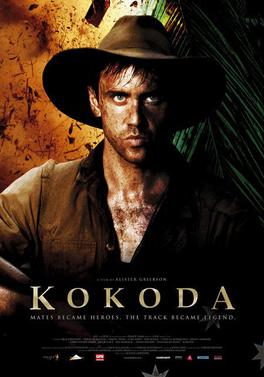“Kokoda” (“Kokoda – 39th Battalion”) is an
Australian war movie directed and co-written by Alistar Grierson. The original idea was to do a treatment of
the Kokoda Trail campaign, but budget constraints pared the film down to the
story of a small unit involved in the campaign.
The movie was a hit in Australia.
A narrator tells us it is 1942 and Australia is being
threatened by Japanese forces that have landed in New Guinea. They are crossing the Owen Stanley Range to
capture Port Moresby in preparation for a planned invasion of Australia. The Japanese have taken Kokoda and are
pressing on to Isurava. Since the
Australian Imperial Forces are committed to North Africa, the defense of the
trail is assigned partly to a militia unit called the 39th
Battalion. These conscripts are
ill-trained and ill-supplied and many are just plain ill with dysentery and
malaria. They are nicknamed “chocos”
because it is assumed they will melt when put in the heat of conflict.
| Do these guys look like they will melt? |
This is a small unit, “who will survive?” movie. It is also firmly in the subgenre of “the
lost patrol”. A group of seven men are
sent on a reconnaissance patrol. Almost
immediately they lose their veteran AIF lieutenant when the Japanese sneak up
on their position. The remainder of the
squad has to try to survive the trip back to their lines. Leadership is assumed by Jack (Jack Finsterer). Their movement is through thick jungle infiltrated
by a crafty, faceless enemy. The group
gets whittled down by several encounters with the Japanese. One of the men suffers a leg wound and
sacrifices himself for the good of his mates.
Jack’s brother Max is hit in the stomach and they have to carry
him. This leads to the standard command
dysfunction between Jack and Darko (Travis McMahon) over whether to abandon
Max. Eventually some of the men get back
in time to help with the defense against the Japanese human wave attacks.
The movie is based on an incident in the Kokoda Trail
campaign which took place from July-November, 1942. A small patrol was cut off and had to return
in spite of lack of food and water and having to carry the wounded. They got back in time to help in the Battle
of Isurava. That battle occurred after
the Japanese had captured Kokoda and was moving across the Owen Stanleys. The Battle of Isurava was a blocking action
that temporarily halted the Japanese drive.
Because of the lack of supplies, the ill-health of the army, and the
persistence of the Japanese, the Australians were forced to withdraw. The “chocos” did not melt away and in fact
fought hard under very difficult conditions.
The movie pays tribute to their effort. The battalion was down to thirty-two fighting
men when it was pulled out of the front line.
Soon after, the unit was disbanded.
| Having watched "Predator", Jack gets an idea |
I love war movies that bring to light a deserving
event, unit, or person. This is one of
those movies and it enlightens in an entertaining way. It is low budget so it has its limitations. Part of this is tempered by the
claustrophobic nature of the jungle setting.
The cinematography makes you feel you are in the thick of it. There is some fly on the wall (or trees)
camerawork. You don’t need a big budget
to show the nasty nature of jungle warfare.
The movie’s depiction of dysentery leaves little to the imagination, for
instance. “Feels like your guts coming
out of your bum.” Some of the men slit
their pants to make relieving themselves more convenient. That’s the first time I had seen that in a
movie. The combat is of the modern
frenetic style. There is a confused
fire-fight and the Japanese night assault.
The movie could easily be mistaken for a Vietnam War movie.
Several of the actors had their
first significant roles. They perform
adequately. Unfortunately, there is
little character development. We don’t
even get the usual campfire back-stories. I did not particularly care for any
of the main characters, but the movie does a good job encouraging empathy for
the 39th Battalion. They
saved money on the Japanese actors as you hardly see a face. The movie does make it quite clear that they
are the villains. There is a bayonet to
the face of a wounded Aussie and a torture scene. The movie is pretty graphic in its
violence. It does an excellent job depicting
the hardships the soldiers went through.
The Kokoda Trail campaign was one of the most unpleasant of the
war. War movies have conditioned us to
believe that nothing was worse than the trench warfare on the Western Front in
WWI. The truth is that there were
environments in WWII that were worse.
| Want to see who didn't make the poster? |
“Kokoda” is a lesser Australian war movie. Although sometimes compared to “Gallipoli”,
it is not in the same league. It should
have been a lot better. It does not take
full advantage of the eeriness of the jungle environment. It fizzles toward the end as the remaining
three survivors have a fairly easy, unsuspenseful last lap. It also pulls its punches with Max’s
situation. With that said, it is still worth a look. Those blokes were worth it.
GRADE = B-

Thanks for the review. I'll keep an eye out for this one. The terrain and logistics of the Kokoda trail campaign were so harsh that it would probably be possible to make a compelling movie focused entirely on travel to and from the front lines.
ReplyDeleteThe Japanese soldiers did in fact earn the title of villains in that theater of the war.